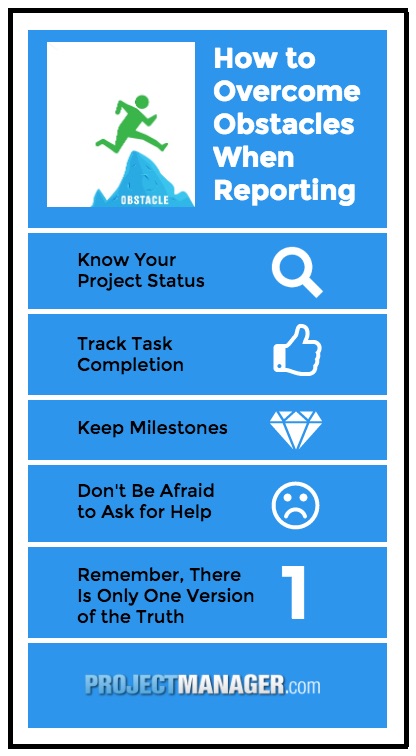5 Ways to Improve Project Reporting
5 Ways to Improve Project Reporting
Reporting on the status of your project is one of your responsibilities as a project leader. You’re not only reporting to your project sponsor (or leadership), but noting for yourself and your team whether things are on track to complete the work on time.
If knowledge is power, then reporting is how you learn.
You know this, though. And you also know that complacency is death, but even the best of us get in a rut with our project reporting. That’s why we’ve collected a handful of helpful tips to on how to improve your reporting.
1. Project Status
You’re going to need to compare your actual versus planned efforts, as well as the percentage completed and actual against the forecast spend. This is most easily accomplished by creating a weekly Project Status Report. You’ll also need to note the number of open risks, changes and issues in your project, and state if action by your sponsor is needed or not to resolve them.
Then there’s the estimate of the duration, effort and financial commitm ent required to finish the project. The more accurate you can forecast these items, the better. Try not to be overly optimistic, however, it’s better to fall on the side of cautious conservatism.
ent required to finish the project. The more accurate you can forecast these items, the better. Try not to be overly optimistic, however, it’s better to fall on the side of cautious conservatism.
 ent required to finish the project. The more accurate you can forecast these items, the better. Try not to be overly optimistic, however, it’s better to fall on the side of cautious conservatism.
ent required to finish the project. The more accurate you can forecast these items, the better. Try not to be overly optimistic, however, it’s better to fall on the side of cautious conservatism.2. Task Completion
Your sponsor is going to want to see a regular report on your progress against your scheduled tasks. Therefore, you need to make your project plan with a view that summarizes and updates to reflect the percentage of each task completed.
Append this view to your Project Status Report so your sponsor can drill down into every one of your tasks if they want further information.
Having both summary and detailed information reports weekly gives your project the transparency they sponsor is going to need in order to feel comfortable about the progress of your work.
By having your sponsor able to understand the project intimately, with all of the tasks available to them to access at a glance, you create “buy-in” from your sponsor and that builds trust and more support when you need it over the lifecycle of the work.
3. Milestones
In order to show when major project deliverables have been met you need to create milestones to your project plan. Your sponsor wants not only the micro but, obviously, the macro progress of your project and this is a sure way to keep them in the loop.
In fact, more than just reporting on the completion of big milestones, you’ll want to show the progress of each milestone’s percentage of completion and forecast the estimated date of full completion of that milestone. The more involved your sponsor is with the movement of your work, the more comfortable they are and the more help they can provide.
Pro-Tip: Get more from your team members by focusing on milestone completions rather than tasks. The tasks are the small steps that lead to the larger accomplishment and, generally, people are very proud of what they’ve achieved in life, which is like a milestone in your project, more than they are about those things they had to do to get there, which are—you guessed it—the tasks. You’ll find this is a helpful technique to motivate your resources.
4. Getting Help
Don’t sugar coat your reports. To tell the truth is better than to lie. Not to be moralistic, but stakeholders are not going to respond well to a report that falsely states that things are moving on target and within the proposed budget. They will discover that’s not really the case, and they’ll not be happy. All you’ve done is denied an issue, pushed it aside, and by so doing created a bigger problem.
The reality is if you’re behind schedule or over budget, then tell your stakeholders and work with them. They can help you resolve issues that may not be in your power to resolve. This is precisely one of the reason why project reporting was developed. It’s not easy to bring problems to your sponsor, but if you are clear about what you need from them, illustrate how you’re doing the best you can with what you have, and show that that you’re the person to best deliver the project, they’ll be an ally to help you deliver the project by offering their help.
You will not get what you don’t ask for. Whether it’s money, time or resources, don’t be afraid to ask for them. The best time to do this, of course, is before you really need it. That way you have contingency and time for help to arrive.
5. One Version of the Truth
A project report is not a literary work. There’s no room for ambiguity. You need clarity in communicating the “one version of the truth” to your team. You also need accuracy and transparency about what is impacting your team. They need to know what the real course of the project is in order to more effectively help you drive it to completion.
Just as you seek help from your sponsor, you’ll need the support of your team to resolve the problems that inevitably come up in your project. By reporting these issues, you share the responsibility for fixing them.
This is just a general overview of what makes for good reporting.

Comments